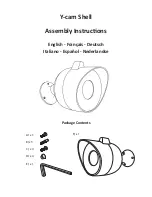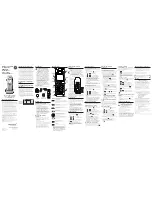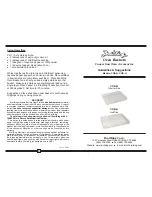
3
Notes on Installation
Clearance between the roof surface and
module frame is required to allow cooling
air to circulate around the back of the
module. This also allows any condensation
or moisture to dissipate. Install modules
so that air can circulate between the roof
and the module.
We recommend installation methods shown
in Figure 2 for VBHNxxxSJ25 series and
Figure 6 for VBHNxxxSJ40 series. In
some areas, local electrical codes may
govern the installation and use of modules.
To avoid the hazard of the electric shock
and fire, do not contact and damage the
back sheet of the module with mounting
bolts.
Operating Conditions
Panasonic recommends that modules be
operated within the following Operating
Conditions. An installation location with
conditions beyond the Operating Conditions or
with other Special Conditions (see below)
should be avoided. Operating Conditions of
Panasonic modules are as follows:
1)
The modules should be operated only in
terrestrial applications. No space or other
Special Conditions (see below).
2)
The ambient temperature should be within
–20°C (-4°F) to 40°C (104°F).
3)
The relative humidity should be within
45% to 95%.
4)
The wind pressure load of the installation
site should be less than 2,400N/m
2
(50PSF).
Special Conditions
1)
The ambient temperature and installation
place are different from the recommended
Operating Conditions.
2)
Salt damage is severe at the installation
place.
3)
Hail and snow damage is excessive at
the installation place.
4)
Sand and dust damage is excessive at
the installation place.
5)
Air pollution, chemically active vapors,
acid rain, and/or soot, etc. are excessive
at the installation place.
SPECIFICATIONS
Notes on Specifications
1)
Rated electrical characteristics are within
from +10% to -5% of the values
measured at Standard Test Conditions
(STC). Irradiance of 1000W/m
2
, 25
o
C
cell temperature, and solar spectral
irradiance per IEC 60904-3.
2)
Under normal conditions, a module may
experience conditions that produce more
current and/or voltage than reported at
standard component test conditions.
Accordingly, the values of Isc and Voc
should be multiplied by a factor of 1.25
when
determining
voltage
ratings,
conductor capacities, fuse sizes, and size
of controls connected to the module
output.
3)
The current output for the modules shown
in the Specifications is measured at
Standard Test Conditions. These conditions
may not be frequently observed in actual
practice.
Application class of product
HIT
○
R
are applied to application class A.
Application class A for modules are defined as
follows:
Class A: General access, hazardous voltage,
hazardous power applications
Module rated for use in this application class
may be used in systems operating at greater
than 50 VDC or 240 W, where general
contact access is anticipated. Modules qualified
for safety through this part of IEC 61730-1
and IEC 61730-2 and within this application
class are considered to meet the requirements
for safety class II.
Fire class of product
HIT
○
R
fill the fire class C that provides to
IEC61730-2. Class C roof coverings are
effective against light fire test exposures. Under
such exposures, roof coverings of this class
afford a light degree of fire protection to the
roof deck, do not slip from position, and are
not expected to produce flying brands.
Mechanical Loading
The modules should be mounted basically
at the four (4) quarter points by the
means shown in Figure 1-1. However,
you may choose the optional mounting
ranges (with limitation of fixing span) by
means shown in Figure 1-2 or Figure 1-
3 for VBHNxxxSJ25 series.
The modules should be mounted basically
at the four (4) quarter points by the
means shown in Figure 5 for
VBHNxxxSJ40 series.
This method offers a maximum load of
2400N/m
2
(50PSF, in a static state)
on the module surface.
CERTIFICATION
VBHNxxxSJ
series
comply
with
the
requirements of IEC61215, IEC61730-1,
IEC61730-2 and the CE mark.
WIRING
General
All wiring should be done in accordance
with applicable electrical codes.
All wiring should be done by a qualified,
licensed professional.
Wiring should be protected to help ensure
personal safety and to prevent its
damage.
All modules connected in series should be
of the same model number and/or type.
Do not connect modules in parallel
without using a connection box.
Do not disconnect terminals while modules
generate electricity and connect electrical
load to avoid the hazard of electrical
shock.
To avoid the hazard of electric shock and
sparks, please connect each cable after
confirming the polarity of them is correct.
Cable conduits should be used in
locations where the wiring is inaccessible
to children or small animals.
Module Wiring
The maximum number of VBHNxxxSJ25
series that can be wired in series is
seventeen (17).
The maximum number of VBHNxxxSJ40
series that can be wired in series is
thirteen (13).
Modules shall not be wired in parallel
without maximum over current protection.
When installing a PV array, the system
design must be completed with reference
to the module electrical specifications for
proper selection of inverters, fuses,
breakers, charging controllers, batteries
and other storage devices.
These modules contain factory installed
bypass diodes. If these modules are
connected each other incorrectly, the
bypass diodes, cable, or junction box
may be damaged.
Array Wiring
The term “array” is used to describe the
assembly of several modules on a support
structure with associated wiring.
Use copper wire that is sunlight resistant
and is insulated to withstand the
maximum possible system open circuit
voltage.
Check your local codes for requirements.
Earth Ground Wiring
The kind of the earth construction shall
conform to IEC61730-1.
Grounding should be carried out by the
attachment to the module or array frame,
to avoid the hazards of electric shock or
fire.
Module Terminations
A junction box as a terminal enclosure is
equipped for electrical connections on
modules.
Modules are equipped with SMK plugs as
a terminal enclosure. Use these
SMK
plugs for electrical connections.



























